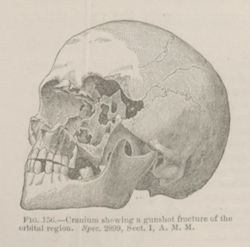Title: C——, Charles
Source text: Surgeon General Joseph K. Barnes, United States Army, The Medical and Surgical History of the War of the Rebellion. (1861–65.), Part 1, Volume 2 (Washington, D.C.: Government Printing Office, 1870), 326.
Civil War Washington ID: med.d1e17410
TEI/XML: med.d1e17410.xml
CASE.—Private Charles C——, Co. H, 30th North Carolina Regiment, aged 30 years, received, at the battle of the Wilderness, May 7, 1864, a gunshot wound of the face. The missile entered the left temple, passing obliquely anteriorly, and emerging one inch below the left eye, severely fracturing and comminuting the superior maxilla, and completely destroying the nasal bones. He was among the captured wounded sent on hospital transports to Washington, and on May 14th was admitted to Carver Hospital. He was very low, and in a comatose state, requiring considerable exertion to arouse him sufficiently to partake of food and stimulants, which were freely administered. He took a quart of milk punch daily. Detergent lotions were applied to the wound. The contents of the left orbit were evacuated, and the vision was destroyed in the right eye. Inflammation gradually extended to the brain; but without any very violent symptoms. The patient survived twenty days, death resulting May 27th, 1864. Acting Assistant Surgeon J. E. Winants reported the case and sent the specimen, figured in the wood-cut (FIG. 156), to the Army Medical Museum. The right malar, the bodies of both superior maxillaries, both lachrymal bones, the body of the ethmoid, with the turbinated bones, the left great ala of the sphenoid, and the left external angular process of the frontal with the orbital plate have been carried away. The left parietal is fissured from the anterior inferior angle to the parietal eminence. The left palate bone is fractured across, the sphenoid cells are exposed, and the cranial cavity is freely opened. The edges of the fractured bones are slightly necrosed and show traces of an attempt at repair.
